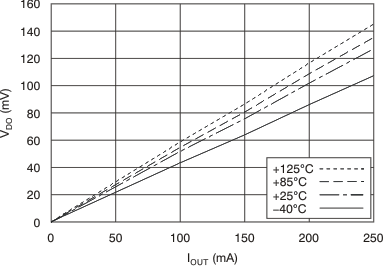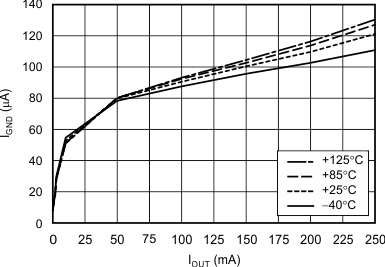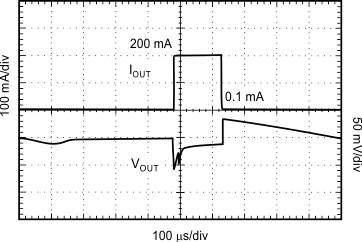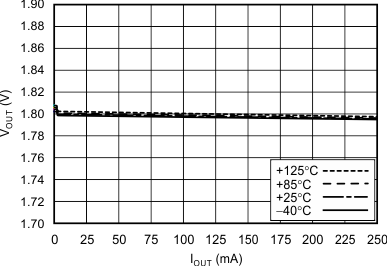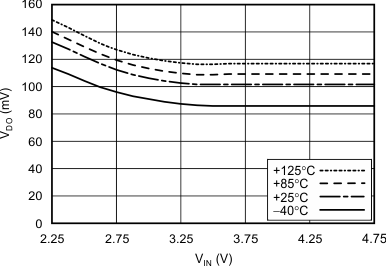SBVS128F June 2009 – December 2015 TPS727
PRODUCTION DATA.
- 1 Features
- 2 Applications
- 3 Description
- 4 Revision History
- 5 Pin Configurations and Functions
- 6 Specifications
- 7 Detailed Description
- 8 Applications and Implementation
- 9 Power-Supply Recommendations
- 10Layout
- 11Device and Documentation Support
- 12Mechanical, Packaging, and Orderable Information
Package Options
Refer to the PDF data sheet for device specific package drawings
Mechanical Data (Package|Pins)
- YFF|4
- DSE|6
Thermal pad, mechanical data (Package|Pins)
Orderable Information
6 Specifications
6.1 Absolute Maximum Ratings
at TJ = –40°C to +125°C (unless otherwise noted); all voltages are with respect to GND(1)| MIN | MAX | UNIT | ||
|---|---|---|---|---|
| Input voltage range, VIN | –0.3 | +6.0 | V | |
| Enable voltage range, VEN | –0.3 | +6.0(2) | V | |
| Output voltage range, VOUT | –0.3 | +6.0 | V | |
| Maximum output current, IOUT | Internally limited | |||
| Output short-circuit duration | Indefinite | |||
| Operating junction temperature, TJ | –55 | +150 | °C | |
| Storage temperature, Tstg | –55 | +150 | °C | |
(1) Stresses above these ratings may cause permanent damage. Exposure to absolute maximum conditions for extended periods may degrade device reliability. These are stress ratings only, and functional operation of the device at these or any other conditions beyond those specified is not implied.
6.2 ESD Ratings
| VALUE | UNIT | |||
|---|---|---|---|---|
| V(ESD) | Electrostatic discharge | Human body model (HBM), per ANSI/ESDA/JEDEC JS-001, all pins(1) | ±2000 | V |
| Charged device model (CDM), per JEDEC specification JESD22-C101, all pins(2) | ±500 | |||
(1) JEDEC document JEP155 states that 500-V HBM allows safe manufacturing with a standard ESD control process.
(2) JEDEC document JEP157 states that 250-V CDM allows safe manufacturing with a standard ESD control process.
6.3 Recommended Operating Conditions
over operating junction temperature range (unless otherwise noted)| MIN | NOM | MAX | UNIT | ||
|---|---|---|---|---|---|
| VIN | Input voltage | 2 | 5.5 | V | |
| IOUT | Output current | 0 | 250 | mA | |
| TJ | Operating junction temperature range | –40 | +125 | °C | |
6.4 Thermal Information
| THERMAL METRIC(1) | TPS727 | UNITS | ||
|---|---|---|---|---|
| DSE (WSON) | YFF (DSBGA) | |||
| 6 PINS | 4 PINS | |||
| RθJA | Junction-to-ambient thermal resistance | 190.5 | 160 | °C/W |
| RθJC(top) | Junction-to-case (top) thermal resistance | 94.9 | 75 | °C/W |
| RθJB | Junction-to-board thermal resistance | 149.3 | 76 | °C/W |
| ψJT | Junction-to-top characterization parameter | 6.4 | 3 | °C/W |
| ψJB | Junction-to-board characterization parameter | 152.8 | 74 | °C/W |
| RθJC(bot) | Junction-to-case (bottom) thermal resistance(2) | N/A | N/A | °C/W |
(1) For more information about traditional and new thermal metrics, see the IC Package Thermal Metrics application report, SPRA953.
(2) θJCbot is not applicable because there is no thermal pad.
6.5 Electrical Characteristics
Over operating temperature range (TJ = –40°C to +125°C), VIN = VOUT(TYP) + 0.3 V or 2.0 V, whichever is greater; IOUT = 10 mA, VEN = 0.9 V, and COUT = 1.0 μF (unless otherwise noted). Typical values are at TJ = +25°C.| PARAMETER | TEST CONDITIONS | MIN | TYP | MAX | UNIT | |||
|---|---|---|---|---|---|---|---|---|
| VIN | Input voltage range | 2.0 | 5.5 | V | ||||
| VO | Output voltage range | 0.9 | 5.0 | V | ||||
| VOUT (1) | DC output accuracy | TJ = +25°C | –2.5 | +2.5 | mV | |||
| VOUT + 0.3 V ≤ VIN ≤ 5.5 V, 0 mA ≤ IOUT ≤ 200 mA |
–2.0% | ±1.0% | +2.0% | |||||
| VOUT + 0.3 V ≤ VIN ≤ 5.5 V, 0 mA ≤ IOUT ≤ 250 mA |
±1.0% | |||||||
| ΔVOUT | Load transient | 1 mA to 200 mA or 200 mA to 1 mA in 1 μs, COUT = 1 μF |
±50.0 | mV | ||||
| 1 mA to 250 mA or 250 mA to 1 mA in 1 μs, COUT = 1 μF |
±65 | |||||||
| ΔVO/ΔVIN | Line regulation | VOUT(NOM) + 0.3 V ≤ VIN ≤ 5.5 V, IOUT = 10 mA |
8 | μV/V | ||||
| ΔVO/ΔIOUT | Load regulation | 0 mA ≤ IOUT ≤ 250 mA | 20 | μV/mA | ||||
| VDO | Dropout voltage(2) | VIN = 0.98 × VOUT(NOM), IOUT = 10 mA | 6.5 | mV | ||||
| VIN = 0.98 × VOUT(NOM), IOUT = 50 mA | 32.5 | |||||||
| VIN = 0.98 × VOUT(NOM), IOUT = 100 mA | 65 | |||||||
| VIN = 0.98 × VOUT(NOM), IOUT = 200 mA | 130 | 200 | ||||||
| VIN = 0.98 × VOUT(NOM), IOUT = 250 mA | 162.5 | |||||||
| ICL | Output current limit | VOUT = 0.9 × VOUT(NOM) | 300 | 400 | 550 | mA | ||
| IGND | Ground pin current | IOUT = 0 mA, TJ = –40°C to +125°C | 7.9 | 12 | µA | |||
| IOUT = 200 mA | 110 | |||||||
| IOUT = 250 mA | 130 | |||||||
| ISHDN | Shutdown current (IGND) | VEN ≤ 0.4 V, VIN = 2 V, TJ = +25°C | 0.12 | µA | ||||
| VEN ≤ 0.4 V, 2.0 V < VIN ≤ 4.5 V, TJ = –40°C to +85°C |
0.55 | 2 | ||||||
| PSRR | Power-supply rejection ratio | VIN = 2.3 V, VOUT = 1.8 V, IOUT = 10 mA |
f = 10 Hz | 85 | dB | |||
| f = 100 Hz | 75 | |||||||
| f = 1 kHz | 70 | |||||||
| f = 10 kHz | 55 | |||||||
| f = 100 kHz | 40 | |||||||
| f = 1 MHz | 45 | |||||||
| VN | Output noise voltage | BW = 100 Hz to 100 kHz, VIN = 2.1 V, VOUT = 1.8 V, IOUT = 10 mA |
33.5 | μVRMS | ||||
| tSTR | Startup time(3) | COUT = 1.0 μF, 0 ≤ IOUT ≤ 250 mA | 100 | μs | ||||
| VHI | Enable pin high (enabled) | 0.9 | VIN | V | ||||
| VLO | Enable pin low (disabled) | 0 | 0.4 | V | ||||
| IEN | Enable pin current | EN = 5.5 V | 40 | 500 | nA | |||
| UVLO | Undervoltage lock-out | VIN rising | 1.85 | 1.90 | 1.95 | V | ||
| TSD | Thermal shutdown temperature | Shutdown, temperature increasing | +160 | °C | ||||
| Reset, temperature decreasing | +140 | |||||||
| TJ | Operating junction temperature | –40 | +125 | °C | ||||
(1) The output voltage is programmed at the factory.
(2) VDO is measured for devices with VOUT(NOM) ≥ 2.35 V so that VIN ≥ 2.3 V.
(3) Startup time: time from EN assertion to 0.98 × VOUT(NOM).
6.6 Typical Characteristics
Over operating temperature range (TJ = –40°C to +125°C), VIN = VOUT(TYP) + 0.3 V or 2.0 V, whichever is greater; IOUT = 10 mA, VEN = VIN, and COUT = 1.0 μF (unless otherwise noted). Typical values are at TJ = +25°C.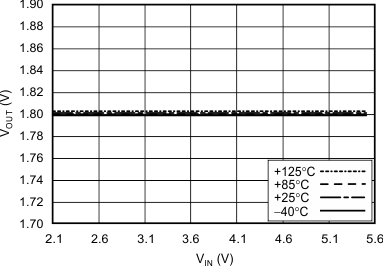
| IOUT = 10 mA |
(TPS72718)
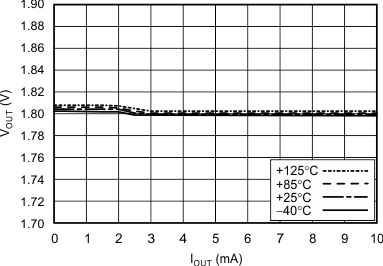
| 0 mA ≤ IOUT ≤ 10 mA |
(TPS72718)
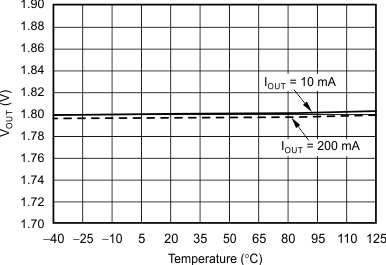
(TPS72718)
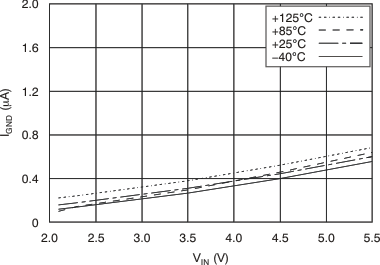
(TPS72718)
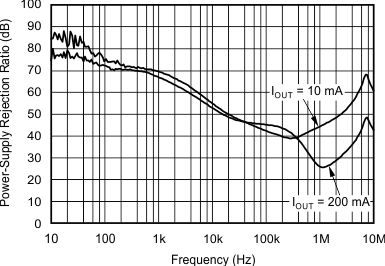
(VIN – VOUT = 0.5 V, TPS72718)
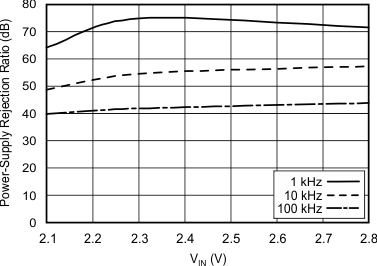
(TPS72718)
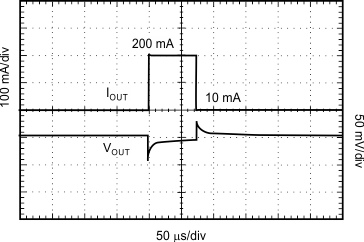
| VIN = 2.3 V, tR = tF = 1 µs |
(TPS72718)
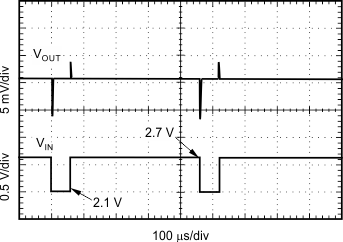
| Slew rate = 1 V/µs, IOUT = 200 µA |
(TPS72718)
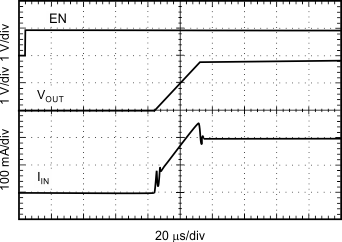
| VIN = 2.1 V, VOUT = 1.8 V, IOUT = 200 mA |
(TPS72718)
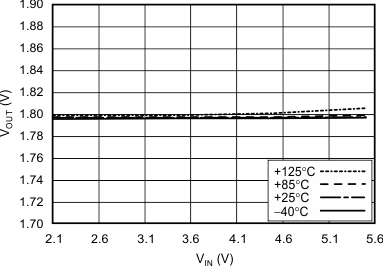
| IOUT = 200 mA |
(TPS72718)
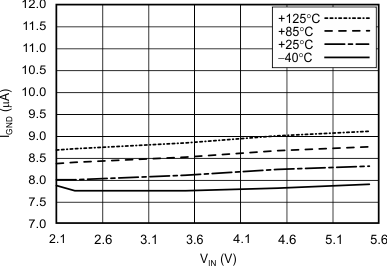
| IOUT = 0 mA |
(TPS72718)
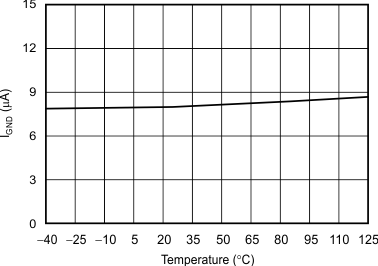
| VIN = 2.1 V, IOUT = 0 mA |
(TPS72718)
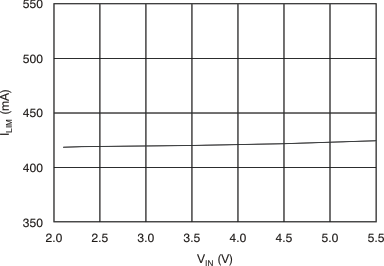
(TPS72718)
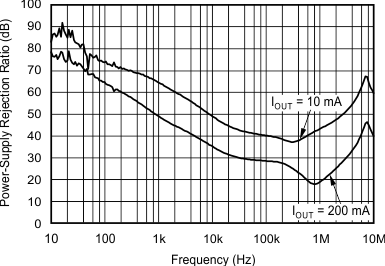
(VIN – VOUT = 0.3 V, TPS72718)
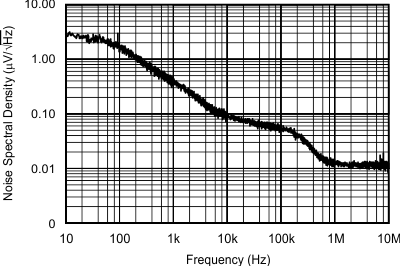
| IOUT = 10 mA, CIN = COUT = 1 µF |
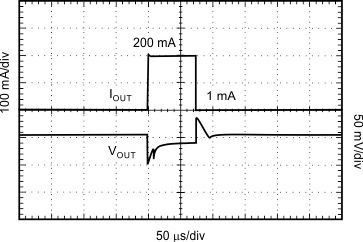
| VIN = 2.3 V, tR = tF = 1 µs |
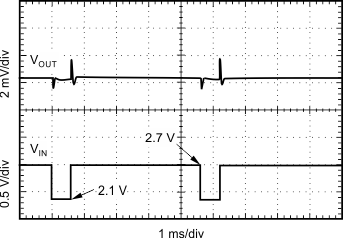
| Slew rate = 1 V/µs, IOUT = 100 µA |
(TPS72718)
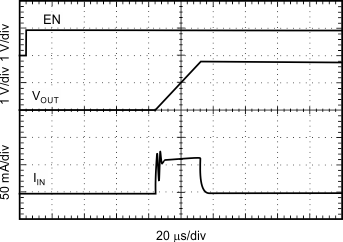
| VIN = 2.1 V, VOUT = 1.8 V, IOUT = 100 µA |
(TPS72718)
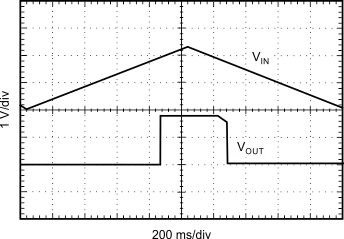
| IOUT = 200 mA |
(TPS72718)
